The Beauty and Function of Lantern Light Chandeliers
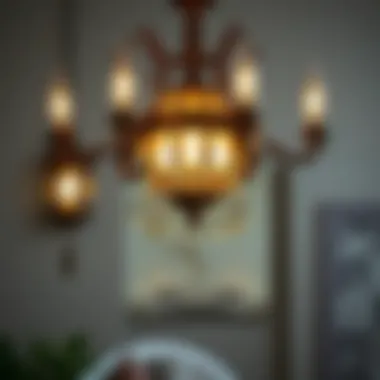
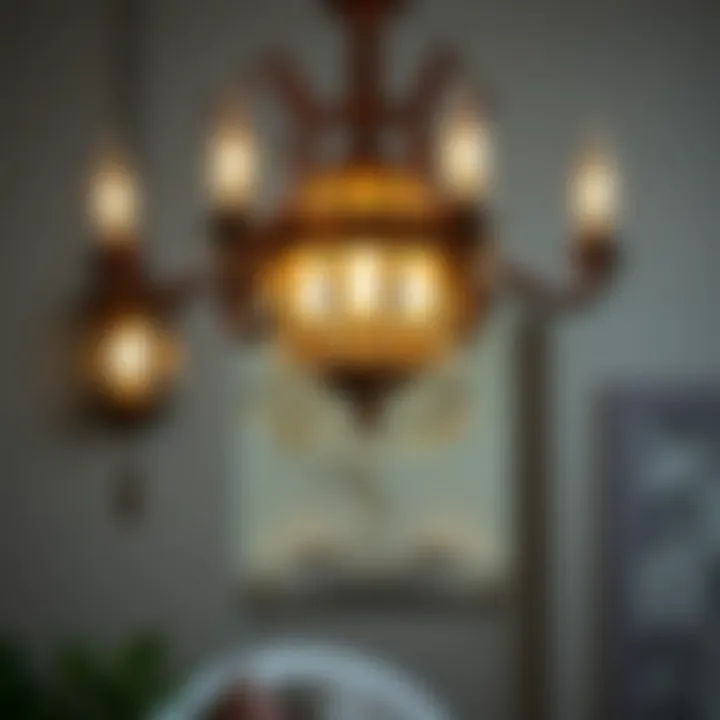
Intro
Lantern light chandeliers have emerged as prominent features in various interior designs, captivating homeowners and decorators alike. These stunning lighting fixtures are not just about illumination; they are architectural statements that have evolved while holding onto their historical roots. With a myriad of styles and materials available, the right lantern chandelier can effortlessly elevate any room, changing its atmosphere completely.
As we delve into the world of lantern light chandeliers, we will analyze their historical significance, variations in design, material choices, and how they contribute to the functionality and beauty of a space. Get ready to engage with the aesthetic and functional facets of these timeless fixtures, guiding you on how to incorporate them into your home decor effectively.
Furniture Design Trends
When it comes to integrating lantern light chandeliers into various decors, understanding the current furniture design trends is essential. The interplay between lighting and furnishings can create cohesive environments that resonate with personal style.
Trending Materials and Textures
Today's market offers a vast range of materials for lantern light chandeliers. Common options include:
- Metal: Often found in finishes like brass, bronze, or steel, metal frames provide durability and a contemporary edge.
- Glass: Clear or frosted glass not only allows light to diffuse beautifully but can also come in intricate designs.
- Wood: For a rustic or farmhouse appeal, wooden structures offer warmth and natural character.
- Ceramics: Unique ceramic lanterns can introduce color and art, making them conversation starters.
Emphasizing textures is crucial too; the feel of an object can affect the overall ambiance. Mixing rough and smooth textures through furniture and lighting can create a layered look that is visually stimulating.
Color Palettes and Styles
Color selection plays a vital role in the integration of lantern light chandeliers. Various styles of chandeliers harmonize with specific color palettes. Consider these popular themes:
- Traditional: Opt for warm tones like golds and browns, reflecting a classic design that evokes elegance.
- Modern: Monochromatic palettes paired with striking metallics create a sleek and contemporary feel.
- Eclectic: Don’t shy away from bold colors and patterns; an unexpected hue can serve as a focal point in an otherwise subdued room.
In addition, combining varied styles with lantern chandeliers can result in delightful contrasts. A vintage chandelier can offer charm in a minimalist setting, bridging different eras and tastes.
"Lantern chandeliers are like a bridge between the old and the new, bringing warmth and a touch of history into contemporary spaces."
Practical Tips for Furniture Selection
Selecting the perfect lantern light chandelier involves assessing both aesthetic appeal and functionality. A well-placed chandelier can illuminate a space while adding character.
Assessing Space and Functionality
Before making a purchase, consider the size and purpose of the room. For example, a large dining room could benefit from a substantial chandelier, while a cozy nook might require a smaller fixture that maintains intimacy. Important pointers include:
- Think about ceiling height; a lower chandelier in a room with higher ceilings can create drama, while a flush mount may work better in cozy settings.
- Consider the amount of light required based on the chandelier's planned location. Spaces like kitchens may benefit from brighter fixtures, while more relaxed areas can opt for softer illumination.
Balancing Aesthetics with Comfort
Finding the balance between style and comfort can be tricky but is vital for overall satisfaction in a living space. Here are some quick tips:
- Choose a design that compliments existing furniture styles.
- Ensure that materials used in the chandelier blend with other fixtures in the room, such as furniture, curtains, and wall color.
- Think practical; ensure the chandelier doesn’t obstruct movement or dominate the space.
Incorporating a lantern light chandelier isn’t just about choosing a light fixture, it’s about creating an experience. Take time to explore options, and reflect on how different styles and placements can transform your living environment.
For more in-depth insights, visit Wikipedia or check out Britannica for a detailed historical overview.
Intro to Lantern Light Chandeliers
Lantern light chandeliers offer a unique blend of style and functionality, making them central pieces in many homes. Their significance often extends beyond mere lighting; they can transform an entire space, creating an atmosphere that embodies warmth, elegance, and even a touch of nostalgia. Understanding the essence of lantern light chandeliers sets the foundation for appreciating their role in modern interior design.
The versatility of these chandeliers is remarkable. Whether placed in a cozy dining area, a grand entrance, or a serene living room, they can either stand out as statement pieces or blend seamlessly with the surrounding decor. For homeowners and designers alike, recognizing this adaptability is key to making informed choices that enhance both aesthetics and usability.
Moreover, lantern light chandeliers draw upon a rich tapestry of history, showcasing the evolution of design trends and material usage over the years. From simple beginnings to intricate, artistically designed fixtures, they reflect cultural movements and artisanal skills that have stood the test of time. This historical significance lends depth to their aesthetic appeal, appealing not only to the eye but also to the intellect.
In navigating the world of lantern light chandeliers, one encounters various considerations—from size and scale to material and style. These elements not only dictate how well a chandelier fits within a room but also influence the overall vibe it creates. Thus, a clear understanding of what lantern light chandeliers are, and the historical context behind their design, is crucial for anyone looking to incorporate them into their living spaces.
The right chandelier can elevate an ordinary room into an extraordinary sanctuary.
As we delve into the specifics, we will explore in detail what exactly defines a lantern light chandelier, as well as its historical significance, setting the stage for further discussions about materials, design variations, and practical applications.
Materials in Lantern Light Chandeliers
Lantern light chandeliers are far more than mere sources of illumination; they encapsulate craftsmanship, design, and a relationship with space, thanks in large part to the materials used in their construction. From metal frames that provide structure to glass enclosures that dictate light diffusion, the choice of materials significantly affects both the aesthetic and functional outcomes of the chandelier. Selecting the right materials can not only enhance the visual appeal of a room but also influence durability, maintenance, and the overall atmosphere created. Here’s an in-depth look at the essential materials that set these chandeliers apart.
Metal Components
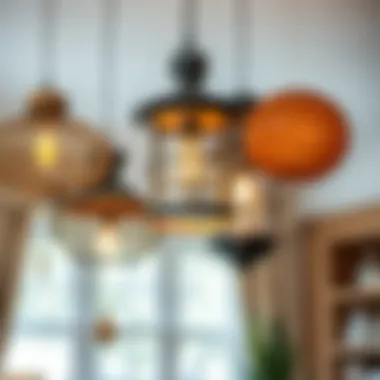
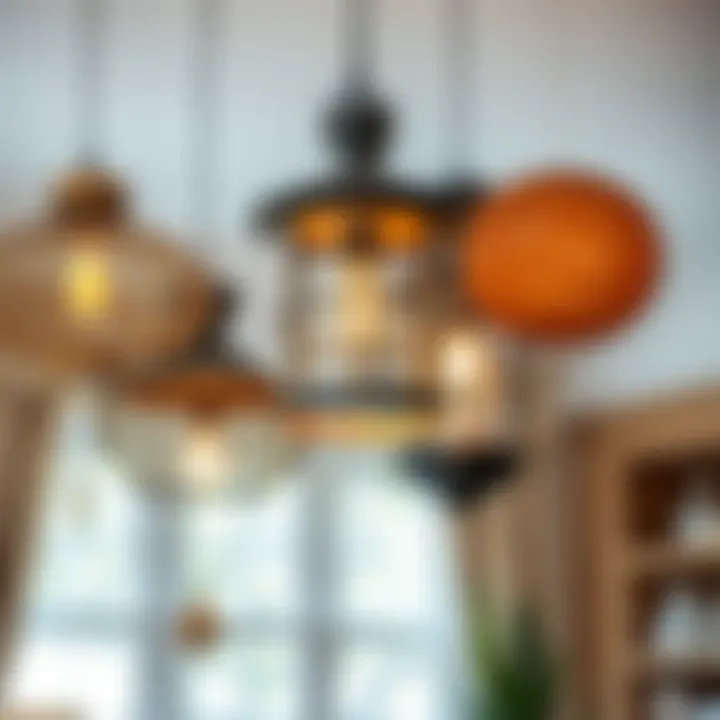
Metal is a fundamental element in the construction of lantern light chandeliers, playing a dual role in form and function. Various types of metal can be employed, including wrought iron, brass, and aluminum. Wrought iron offers a rustic charm, often associated with traditional design, while brass adds a touch of elegance, suggesting sophistication and warmth. Aluminum, being lightweight and resistant to corrosion, is increasingly popular in modern designs.
When choosing metal for chandeliers, consider not only the visual aesthetics but also maintenance requirements. For instance, brass may develop a patina over time, which some homeowners find desirable, while others might prefer a more polished appearance. The choice of metal also impacts the chandelier’s weight — an important consideration when installing it in different settings.
"Metal components can dictate the entire character of a chandelier—its strength, style, and suitability for various environments."
Glass Enclosures
Glass is where the true artistry of lantern light chandeliers shines. The style, thickness, and type of glass greatly affect how light is emitted, creating different atmospheres in a room. For instance, clear glass enclosures can enhance brightness, making spaces feel larger and airy, whereas frosted or colored glass can produce a softer, more intimate ambiance.
There are various styles of glass that can be utilized, including:
- Etched Glass: Adds a decorative touch while diffusing light gently.
- Crystal Glass: Known for its brilliance, this type refracts light in a dazzling way, often used in more opulent settings.
- Recycled Glass: Eco-conscious homeowners may opt for sustainable options that not only look beautiful but also contribute to environmental responsibility.
The choice of glass can also play a significant role in maintenance; clear glass may highlight dust and fingerprints, necessitating more frequent cleaning, while frosted varieties might conceal such signs better.
Wooden Elements
Wooden elements in lantern light chandeliers are less common but offer a unique charm and warmth that metal and glass cannot replicate. Wood, often used in conjunction with metal, can soften the overall aesthetic and create a more homely, grounded feel. From oak to walnut, the type of wood selected can influence color, grain, and texture, offering a richness that is both tactile and visual.
Moreover, wood components can also impact the weight and structural integrity of a chandelier. While they add a beautiful rustic touch, it's crucial that wooden elements are treated to resist moisture, especially in areas prone to humidity.
In summary, the materials used in lantern light chandeliers hold significant weight in determining not only how they look but also how well they perform in a space. A thoughtful selection of metals, glass, and wood not only enhances design but can further elevate the atmosphere of the environment they inhabit.
By keeping in mind the balance between aesthetics and practicality, homeowners and designers can better ensure that their selection of materials will harmoniously integrate with the overall decor while serving functional needs.
Design Variations of Lantern Light Chandeliers
Design variations of lantern light chandeliers hold a significant place in the world of interior design. The myriad choices available allow homeowners and designers to tailor their lighting aesthetic to match specific tastes and functional needs. Lantern light chandeliers are not merely functional pieces; they serve as eye-catching focal points that can profoundly influence the atmosphere of a space. Understanding these variations can make all the difference when striving for that perfect balance of style and utility.
Traditional vs. Contemporary Styles
When considering styles, traditional lantern light chandeliers often evoke a sense of nostalgia. These fixtures are typically characterized by intricate metalwork, elaborate designs, and historical influences. A classic example is a wrought iron lantern chandelier adorned with aged glass; these elements can harken back to a time when craftsmanship meant everything. They suit homes with a rustic charm or those aiming for a vintage look.
On the other hand, contemporary styles lean towards minimalism and clean lines. Contemporary lanterns might use industrial materials such as brushed steel or even versatile resin, favoring function while making a bold statement. They often come in geometric shapes that resonate with modern architectural elements, making them versatile for various settings, from urban lofts to sleek suburban homes.
There’s beauty in the blending of these styles too. A contemporary lantern with vintage accents or traditional craftsmanship can create an unexpected, yet harmonious aesthetic. For instance, a modern chandelier designed like an antique lantern can bridge the gap between old and new, providing depth to the overall decor.
Size and Scale Considerations
The size and scale of a lantern light chandelier play a pivotal role in its impact on a room. A chandelier that’s too small may get lost in a large space, losing its intended effect. Conversely, an oversized piece might overwhelm a cozy room, creating an oppressive atmosphere instead of a welcoming one. Therefore, measuring the space is essential before making a selection.
In general, a good rule of thumb is that a chandelier should hang about 30 to 36 inches above the surface of a dining table. For ceiling heights over eight feet, add three inches per additional foot of height. This helps achieve a balanced visual appearance. For example, in a grand entryway with soaring ceilings, a larger chandelier with a larger spread of light is necessary to fill the vertical space adequately.
Additionally, the number of lights in the chandelier should correspond with the area that needs illumination. A grand dining room might benefit from a larger chandelier featuring multiple bulbs, illuminating not just the table but the whole room. On the contrary, a smaller kitchen nook might require something more understated but still elegant, perhaps with just a few strategically placed lights.
Ultimately, the design variations of lantern light chandeliers not only elevate the aesthetic appeal of a space but also serve practical purposes by influencing the overall ambiance, making careful consideration essential in any decorating endeavor.
Finding the Right Setting
Choosing the right setting for lantern light chandeliers can profoundly affect both the aesthetic and functional aspects of a space. It's not just about hanging a pretty piece from the ceiling; it's about creating an atmosphere that enhances the overall design language of your home. The placement and style of chandeliers need to be thoughtfully aligned with the character of each room. A well-positioned chandelier serves not only as a source of light but as a statement piece that embodies personality and style.
Lamplights can cast an inviting glow, moving beyond their practical utility, transforming ordinary spaces into cozy havens or elegant settings. When selecting a location for your chandelier, consider the dimensions of the space, the height of the ceiling, and even the existing color schemes and furniture styles. Each of these factors can dramatically influence the chandelier's impact.
"The right lighting can turn a house into a home" - unknown
Living Rooms
In living rooms, lantern light chandeliers can serve as the centerpiece, drawing the eye upwards and creating a sense of grandeur. The style of the chandelier should harmonize with the overall theme of the living area—be it a rustic farmhouse vibe or a sleek modern aesthetic.
When installing a chandelier in the living room, think about the following:
- Height: The chandelier should hang at least seven feet above the floor to ensure it does not obstruct views or become a hazard.
- Size: It should be proportionate to the size of the room. A chandelier that’s too small may get lost, while one that’s too large can overwhelm the space.
- Color: Consider the dominant colors within the room; a brushed gold chandelier may complement warmer tones, whereas a sleek, black contemporary model fits better with cooler hues.
Engaging the visual senses through careful arrangement creates an inviting ambience that enhances conversations and gatherings. Thus, a lantern light chandelier becomes more than a fixture; it evolves into a focal point that embodies the identity of the space.
Dining Areas
In dining areas, the chandelier's role amplifies further. It is often the anchor around which the rest of the furnishings are arranged. Under the soft glow of a lantern-type chandelier, meals become an aesthetic experience, elevating them beyond merely functional gatherings.

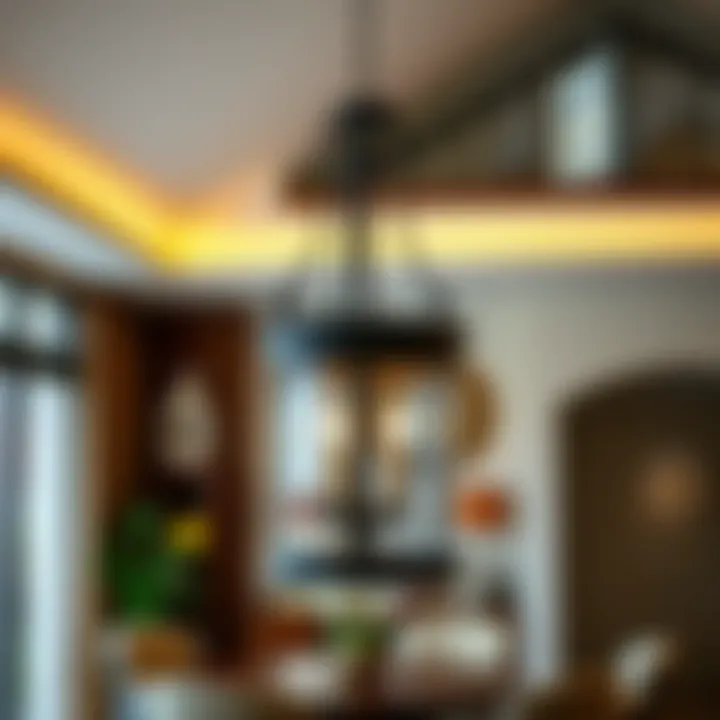
Considerations for dining areas include:
- Positioning: Ideally, the chandelier should be centered above the dining table with a height that allows for unobstructed views. A distance of 30-36 inches above the tabletop is generally recommended.
- Shape: The chandelier’s shape can create different moods; for instance, a circular chandelier can promote a more congenial atmosphere, while a square design might lean toward a more formal feel.
- Dimming Features: Opt for a chandelier that supports dimming. This feature allows you to adjust the ambiance from lively family dinners to intimate gatherings.
Ultimately, the goal is to create a space where conversations can flow as freely as the wine served at dinner, setting the stage for joyous memories.
Entryways and Foyers
Entryways and foyers provide the first impression of your home. A lantern light chandelier can set the tone right from the moment guests walk through the door. It’s the very antithesis of understatement, making a bold statement while welcoming visitors with warmth.
Here are important factors to keep in mind for entryway designs:
- Scale and Size: A larger chandelier can create drama in spacious entryways, while smaller models can work in tighter spaces, avoiding a cluttered feel.
- Design Continuity: The chandelier should echo design elements found throughout the house, maintaining a harmonious flow.
- Lighting Type: Choose warm, inviting light to make the entry feel welcoming. Bright lights can sometimes be jarring, which is not the intended effect in a welcoming space.
Focusing on these elements ensures that the light fixture is not just a source of illumination, but a piece of art that enhances the character of your home.
Integrating Lantern Light Chandeliers into Decor
Incorporating lantern light chandeliers into decor plays a crucial role in bridging the aesthetic with the functional. These unique fixtures do more than provide illumination; they serve as artistic statements that can elevate the overall atmosphere of a space. Understanding how to integrate them within an existing decor scheme is essential for homeowners and designers alike, as it impacts both the ambiance and usability of a setting.
When it comes to bringing together various elements of design, lantern light chandeliers offer immense versatility. They fit seamlessly into a plethora of themes, ranging from rustic charm to modern minimalism. Moreover, choosing the right chandelier enhances not only the visual appeal but also creates a layered lighting effect that defines the character of a room. Thus, careful consideration is vital in selecting a design that complements both style and purpose.
Color Coordination
In the realm of interior design, the palette can make or break a decorating scheme. When thinking about lantern light chandeliers, color coordination becomes pivotal. Select a chandelier that harmonizes with the shades prevalent in your furniture and walls. For instance, a copper-finished lantern can beautifully contrast against a cool blue wall, adding warmth and a vintage vibe.
Here are some essential tips for color coordination:
- Stick to a theme: If your room features earth tones, opt for materials in bronze or muted brass.
- Consider accent colors: A chandelier can introduce a pop of color through stained glass or painted finishes, aligning itself with other accent pieces in the room.
- Balance with neutrals: Use a neutral color for your walls if your lantern light chandelier has an intricate design. This lets the fixture take center stage without overwhelming the space.
Complementing Furniture Styles
Lantern light chandeliers can act as a unifying element, enhancing the cohesion of room decor. They can complement various furniture styles, providing continuity throughout different areas of the home. For a farmhouse-inspired room, a wooden lantern frame can echo the textures found in reclaimed wood furniture.
- Traditional settings: A classic wrought-iron chandelier adds sophistication, aligning well with heavy wooden furniture.
- Modern spaces: For contemporary interiors, minimalist lanterns with glass accents can coolify bold colors and clean lines without clashing with the sleek aesthetics.
- Eclectic mixes: Feel free to mix styles. A vintage-style lantern might stand out beautifully against mid-century modern chairs, creating a conversation starter.
Creating Focal Points
One of the best uses of a lantern light chandelier lies in its ability to draw the eye and create a focal point. Regardless of size, these fixtures can anchor a room by directing attention to a significant area, such as a dining table or an entryway. The right placement and design not only illuminate but also enhance social interactions.
"A well-placed lantern light chandelier transforms an average space into a magnetic gathering point."
Consider these strategies when positioning your chandelier:
- Above the dining area: Hanging a chandelier directly over a dining table establishes an inviting atmosphere during meals and gatherings.
- Entryway magic: A striking lantern in a foyer welcomes guests while showcasing style right from the entrance.
- Layering heights: Combining chandeliers of varying heights creates visual interest while maintaining harmonized lighting across different levels.
Illumination and Atmosphere
When it comes to the visual allure of a home, illumination plays a pivotal role. Lantern light chandeliers not only serve as a source of lighting but also enhance the overall atmosphere in various spaces. Their placement, design, and the type of light emitted can transform a mundane room into a captivating environment, elevating both aesthetic and functional appeal.
The very essence of a room's mood is often dictated by how it is illuminated. The soft glow of a lantern chandelier can create a warm and inviting atmosphere, making it an ideal choice for settings like living rooms or dining areas. Think about it: when visitors step into a space flooded with soft, warm light, they often feel a sense of comfort and ease, which is much more inviting than stark, artificial lighting. This is where understanding the types of lighting used becomes significant.
Type of Lighting Used
The variety of bulbs that illuminate lantern chandeliers is crucial in shaping both aesthetic aspects and the functional capacity of spaces. Many chandeliers can incorporate several types of bulbs:
- Incandescent bulbs: Known for their warm, yellowish light, they add a classic touch but can be energy-consuming.
- LED bulbs: These have gained popularity due to their energy efficiency and longevity. The cool white or warm white options enable customization of the atmosphere, appealing for various interior themes.
- Halogen bulbs: They provide a crisp, bright light, perfect for enhancing details in decor, but they run hotter and consume more electricity compared to LEDs.
Choosing the right type of lighting can either complement or complete the design vision. Those who prefer a vintage look may opt for incandescent, while modern spaces often incorporate LEDs for a streamlined effect.
Adjusting Brightness and Ambiance
Adjustability plays a vital role in maintaining both aesthetic appeal and functional use in a space. Lantern light chandeliers equipped with dimmable features offer homeowners the ability to tailor brightness to suit various occasions or moods. For instance, bright lighting might be beneficial for gatherings or dinners, while a softer, lower light can provide an intimate atmosphere, ideal for quieter evenings.
Consider the following methods to adjust brightness:
- Dimmers: Installing dimmers allows flexibility in lighting control. It empowers you to shift from a vibrant setting to a calm atmosphere effortlessly.
- Smart technology: Modern chandeliers can pair with smart home systems, providing an easy-to-manage interface through apps that regulate brightness and even color temperature.
- Layered lighting: Combining chandeliers with other light sources, like wall sconces or floor lamps, creates depth. Different light sources at varied brightness levels allow for more complex atmospheres to be crafted.
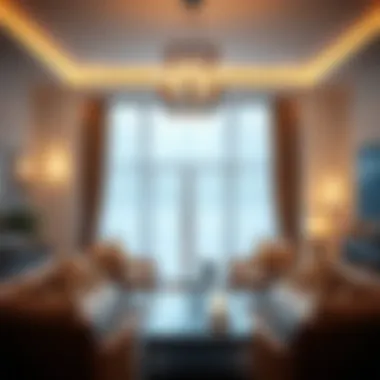
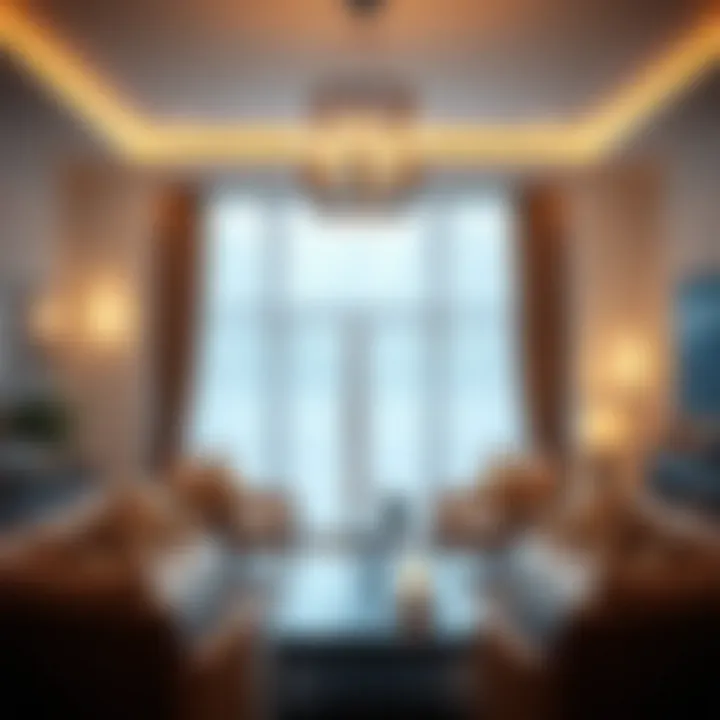
"A well-lit room can become the heart of a home, transforming its ambiance with the flick of a switch."
Maintenance and Care
Keeping lantern light chandeliers in prime condition is not just a matter of aesthetics; it’s about preserving their functionality and longevity. These fixtures can be significant investments in both money and style. Over time, they collect dust, grease, and grime, which can impact their light output and overall appearance. Thus, understanding the best practices for maintenance and care will ensure these beautiful elements of home decor continue to illuminate spaces effectively.
Cleaning Strategies
To maintain a lantern light chandelier's dazzle, regular cleaning is essential. Here’s a series of straightforward strategies:
- Dust Regularly: Use a feather duster or a microfiber cloth to easily wipe away dust and cobwebs from the lantern’s surfaces. It’s usually good practice to do this weekly or bi-weekly.
- Use Mild Soap Solutions: For deeper cleans, mix a few drops of mild dish soap with warm water. Dampen a soft cloth in this solution, wring it out well, and gently wipe down both the metal and glass components.
- Avoid Abrasives: When it comes to removing stains, steer clear of any abrasive cleaners or scouring pads. They can scratch surfaces, tarnishing the beautiful finish of materials like brass or nickel.
- Glass Care: If the chandelier has glass lamps, consider using a glass cleaner or a vinegar-water mixture to restore their clarity. Again, remember to use a soft cloth to avoid scratches.
- Inspect Lighting: Regularly check the bulbs and connectors. Changing bulbs when they’re dim or burnt out ensures optimal lighting, so upgrading to LEDs can also be an energy-efficient choice.
"Regular care can extend the life of lantern light chandeliers, ensuring they shine bright for many years."
Handling Repairs
Even the most carefully maintained chandelier can require repairs over time. Knowing how to address common issues can save you both time and money. Here are a few pointers for handling repairs:
- Identify Problems Early: Flickering lights, buzzing sounds, or physical damage to wires often indicate something needs attention. Catching these issues early can prevent more extensive damage.
- Consult the Manual: If you have access to a manual or warranty information, that’s where to start for specific guidance. Most manufacturers provide insights on handling common repairs and maintenance recommendations.
- Dealing with Wiring Issues: If you encounter any electrical problems, it’s wise to consult an electrician. Attempting to fix electrical wiring without proper knowledge can be hazardous.
- Reattach Loose Parts: Sometimes, the parts may become loose due to age or inferior installation. Check and re-tighten fixtures and screws carefully, ensuring they are secure but not overtightened, which can cause cracking.
- Replacement Parts: For any components that are beyond repair, sourcing the correct replacement is vital. Check with the manufacturer or authorized retailers to find exact parts for seamless repairs.
In sum, by using these cleaning strategies and handling repairs promptly, homeowners can keep their lantern light chandeliers looking splendid and functioning flawlessly, thus maintaining the charm and character they bring to any space.
Trends in Lantern Light Chandelier Design
The design landscape of lantern light chandeliers is continually evolving, influenced by cultural shifts, technological advancements, and changing aesthetic preferences. Understanding these trends is essential for homeowners and designers alike, as it offers the opportunity to enhance the ambiance of interiors while ensuring functionality and sustainability. From eco-friendly materials to smart integrations, these trends illustrate the dynamic interplay between beauty and practicality in modern decor.
Eco-Friendly Options
As environmental awareness rises, many consumers are leaning toward eco-friendly options when it comes to home decor, including lantern light chandeliers. This trend is characterized by the embrace of sustainable materials such as reclaimed wood, recycled metals, and glass that uses less energy during production. More importantly, these materials not only avoid contributing to environmental degradation but also infuse a unique character into the chandeliers.
Choosing eco-friendly chandeliers contributes to lower carbon footprints and supports responsible manufacturing practices. Several designers even take this a step further by utilizing solar-powered lighting in their lantern creations, promoting energy efficiency while offering visually appealing options. Consider:
- Reclaimed Wood Frames: These add rustic charm and tell a story of history.
- Recycled Metal: Durable and stylish, these materials often have unique finishes that enhance aesthetic appeal.
- Low-Energy Bulbs: Such bulbs not only reduce energy consumption but also provide a warm glow, enhancing the ambiance of any space.
Moreover, eco-friendly chandeliers fit well within various design styles, from modern minimalism to traditional farmhouse aesthetics. Integrating these options into decor does not require sacrificing style for sustainability, which is a crucial factor for modern homeowners who wish to maintain aesthetic elegance in harmony with ecological consciousness.
Smart Technology Integration
In a world becoming increasingly connected, incorporating smart technology into lantern light chandeliers is gaining traction. Smart chandeliers level up the user experience by integrating features such as remote control operations and voice-activated assistance. This means homeowners can adjust the lighting intensity, color, and even preset scenes directly from their smartphones or smart home devices.
Benefits of smart technology integration include:
- Enhanced Control: No more staggering around looking for the switch; simply command your chandelier to illuminate or dim, creating the perfect mood effortlessly.
- Energy Efficiency: Smart controls allow for better energy management—set timers or schedules to reduce energy usage when not needed.
- Customizable Experiences: Select from a range of lighting options tailored for different occasions, such as romantic dinners or lively gatherings.
As smart homes become more common, the advent of technology in chandelier design offers not just practicality, but also a stunning aesthetic that merges style with innovation. Homeowners should look for chandeliers from reputable brands that are compatible with established smart home systems, ensuring seamless integration.
"The fusion of tradition and modern technology is making lantern light chandeliers not just a source of light but integral parts of our home’s ambiance and functionality."
The End
In summing up the discourse on lantern light chandeliers, it becomes evident that these fixtures are far more than mere sources of illumination. They embody a rich blend of aesthetics and practicality that can transform a space entirely. Understanding their significance requires delving into the nuances presented in the article: from historical roots to contemporary adaptations, every detail plays a role in defining their appeal.
One notable benefit of incorporating lantern light chandeliers into design is that their unique styles can complement a myriad of interior themes. Be it farm house chic, modern minimalism, or classical elegance, there's a lantern chandelier that fits right in. The materials discussed—metal, glass, and wood—offer endless options for complementing existing decor and establishing a cohesive look.
Additionally, the atmosphere created by these chandeliers can dramatically enhance the comfort of a space. Proper lighting significantly contributes to mood, and lantern chandeliers excel at creating warm, inviting environments characteristic of cozy gatherings or elegant dinner parties.
Key considerations emerge from our exploration:
- Understanding the importance of scale for the space in which they will hang,
- The challenge of maintenance versus the reward of design impact,
- The evolving trends that push boundaries in terms of eco-friendliness and technology integration.
Through careful consideration of these elements, homeowners and decorators can make informed decisions that elevate their interiors while embracing both functionality and charm.
Summarizing Key Points
To distill the essence of our journey through the world of lantern light chandeliers:
- Historical Significance: These fixtures have evolved from traditional torch holders to sophisticated decor.
- Material Diversity: Varied materials not only cater to different styles but also affect lighting quality.
- Design Variations: From traditional shapes to contemporary adaptations, options abound.
- Settings and Placement: Such chandeliers find a home in various spaces, from cozy living rooms to grand entryways.
- Atmospheric Impact: Their ability to create mood enhances the overall experience of a space.
- Maintenance and Care: Options for care ensure longevity and performance.
- Trends: Innovations in design reflect modern sensibilities and eco-conscious choices.
Future of Lantern Light Chandeliers in Design
Looking ahead, the future of lantern light chandeliers shines bright as innovation continues to take center stage within the design realm. The potential for smart technology integration offers a glimpse into a world where lighting adjusts dynamically to the user’s needs, whether it’s considering energy efficiency or enhancing user experience.
Moreover, eco-friendly materials are increasingly being utilized, contributing to sustainability efforts without compromising aesthetic values. Homeowners are more aware of their choices, opting for fixtures that not only decorate their spaces but also align with their values concerning the environment.
In summary, lantern light chandeliers are evolving. They are adapting to modern needs while still retaining their timeless charm. Hence, their relevance in interior design remains undeniable, offering a delightful fusion of function and beauty that appeals to discerning homeowners and designers alike.



